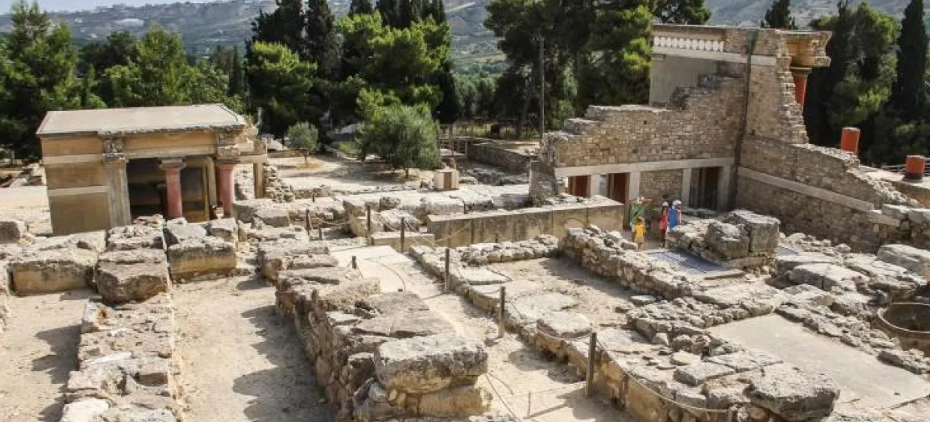The ancient palace of Knossos, located just a few kilometers south of Heraklion on the island of Crete, is one of the most significant archaeological sites in Greece. Renowned for its association with the myth of the Labyrinth and the Minotaur, Knossos offers visitors a fascinating glimpse into the Minoan civilization, which flourished from approximately 2000 to 1450 BCE. Exploring the labyrinthine complex of Knossos is an adventure through time, revealing the architectural ingenuity and cultural richness of the Minoans.
The Myth of the Labyrinth and the Minotaur
The legend of the Labyrinth and the Minotaur is one of the most enduring myths of ancient Greece. According to the myth, King Minos of Crete commissioned the architect Daedalus to build a vast and intricate labyrinth to imprison the Minotaur, a monstrous creature with the body of a man and the head of a bull. The Minotaur was the offspring of Minos’s wife, Pasiphae, and a divine bull. Each year, Athens was required to send seven young men and seven young women as tributes to be devoured by the Minotaur. This cycle of sacrifice continued until Theseus, the hero of Athens, volunteered to enter the Labyrinth and slay the Minotaur, ending the terror and freeing the Athenians from their grim obligation.
The Palace of Knossos
The myth of the Labyrinth is closely tied to the archaeological site of Knossos, which many believe to be the inspiration for the labyrinth in the legend. The palace complex, discovered and excavated by Sir Arthur Evans in the early 20th century, is a sprawling structure that showcases the architectural and artistic achievements of the Minoan civilization.
Architectural Features
The Palace of Knossos is a marvel of ancient architecture, characterized by its complex layout, advanced engineering, and sophisticated design.
- Complex Layout: The palace covers an area of approximately 20,000 square meters and consists of a maze of rooms, corridors, staircases, and courtyards. This intricate design has led many to associate it with the mythical Labyrinth.
- Central Courtyard: At the heart of the palace is a large central courtyard, which served as a focal point for religious and social activities. Surrounding the courtyard are various rooms, including ceremonial halls, storerooms, workshops, and residential quarters.
- Advanced Engineering: The Minoans were skilled engineers, as evidenced by the palace’s advanced drainage and plumbing systems. The complex also features sophisticated architectural elements such as columned porticoes, frescoed walls, and intricately decorated floors.
Artistic Achievements
The artistic accomplishments of the Minoans are vividly displayed in the frescoes, pottery, and artifacts found at Knossos.
- Frescoes: The walls of the palace are adorned with vibrant frescoes depicting scenes of nature, religious rituals, and daily life. Notable examples include the “Bull-Leaping” fresco, which illustrates the Minoan sport of bull-leaping, and the “Prince of the Lilies” fresco, which portrays a figure adorned with lilies and feathers.
- Pottery and Artifacts: The palace has yielded a wealth of pottery, tools, and other artifacts that provide insights into Minoan culture and craftsmanship. These items are characterized by their intricate designs and high-quality workmanship.
Exploring the Site
Visiting the Palace of Knossos offers an immersive experience that transports visitors back to the height of Minoan civilization. As you wander through the site, you can imagine the bustling activity that once filled its halls and courtyards.
Key Areas to Explore
- The Throne Room: One of the most impressive rooms in the palace, the Throne Room features a stone throne flanked by benches and elaborate frescoes. This room is believed to have been used for ceremonial purposes.
- The Grand Staircase: This monumental staircase connects the different levels of the palace and showcases the Minoans’ architectural prowess. The staircase is flanked by elegant columns and leads to the upper floors, which housed living quarters and administrative offices.
- The Queen’s Megaron: This luxurious residential suite includes a large room with a beautifully decorated bathroom and a series of smaller rooms. The Queen’s Megaron is famous for its “Dolphin Fresco,” which depicts dolphins swimming gracefully amidst aquatic plants.
Interpretive Displays and Tours
The site of Knossos is well-equipped with interpretive displays and guided tours that enhance the visitor experience.
- Interpretive Displays: Informative signs and displays are placed throughout the site, providing historical context and descriptions of the various rooms and features.
- Guided Tours: Professional guides offer in-depth tours of the palace, sharing fascinating stories and insights into Minoan culture, the excavation process, and the connection to the myth of the Labyrinth.
The Legacy of Knossos
The Palace of Knossos is not only a testament to the architectural and artistic achievements of the Minoans but also a symbol of the enduring legacy of ancient myths and their influence on our understanding of history.
Cultural and Historical Significance
Knossos remains a vital link to the Minoan civilization, offering valuable insights into their society, economy, and religious practices.
- Archaeological Research: Ongoing archaeological research at Knossos continues to uncover new findings and deepen our understanding of the Minoans. These discoveries contribute to the broader knowledge of ancient Mediterranean cultures.
- Cultural Heritage: Knossos is a UNESCO World Heritage site, recognized for its cultural and historical significance. It attracts visitors from around the world, fostering an appreciation for Crete’s rich heritage and the contributions of the Minoans.
Conclusion
Exploring the ancient Cretan labyrinth at Knossos is a journey through history and mythology, offering a unique glimpse into the world of the Minoans. The palace’s intricate architecture, stunning frescoes, and wealth of artifacts provide a tangible connection to a civilization that thrived over 3,500 years ago. As you walk through the halls and courtyards of Knossos, you can almost hear the echoes of the past and imagine the grandeur and mystery that once defined this ancient site. Visiting Knossos is not just an exploration of an archaeological marvel but also an immersion into the timeless legends and cultural heritage of Crete.


